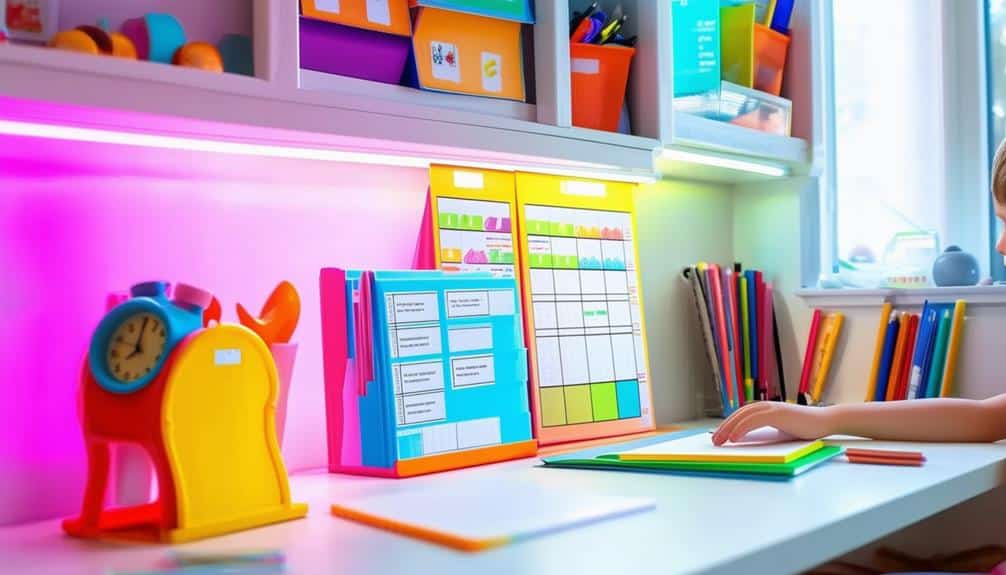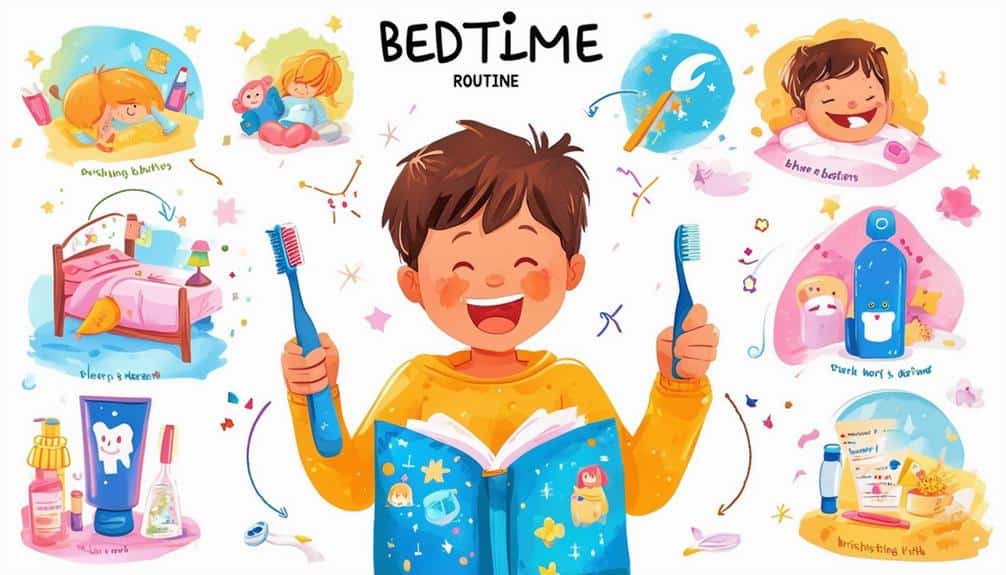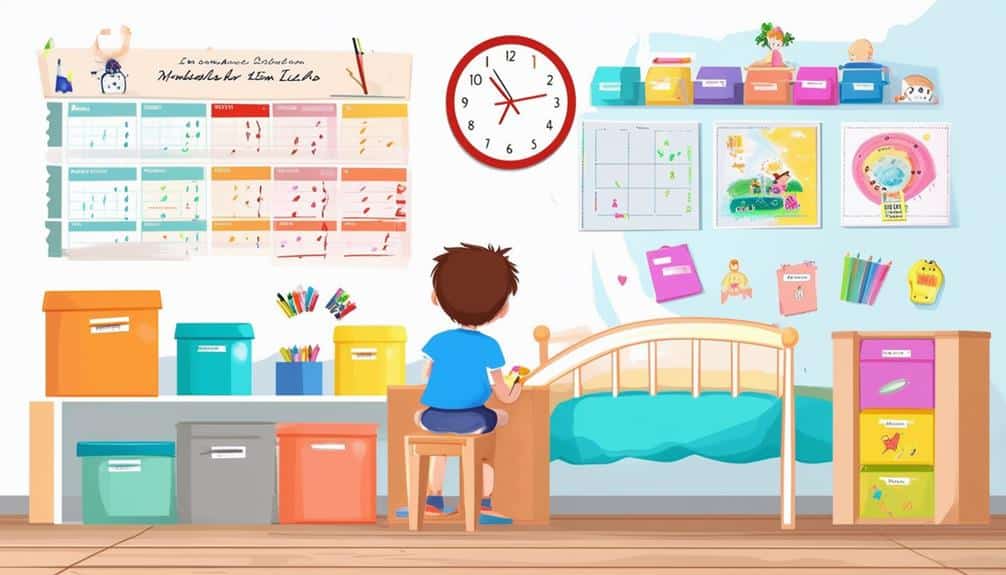Managing Attention Deficit Hyperactivity Disorder (ADHD) in children has proven to be a challenge for many parents and caregivers. However, a consistent routine that caters to the distinct needs of these children can significantly enhance their daily functioning and overall wellbeing. This discussion will explore practical strategies, including 12 effective routines that improve focus, time management, and adaptability in children with ADHD. As we investigate these routines, you’ll gain valuable insights into creating an environment that promotes success for children living with this condition.
Key Takeaways
- Structured morning routines can enhance focus, aid in time management, and set a positive tone for the day.
- Consistent after-school homework time, including short breaks and parental support, promotes productivity and task completion.
- Regular and predictable dinnertime encourages family bonding and teamwork and provides a comforting sense of routine.
- A healthy bedtime routine with relaxation activities and consistent sleep patterns can improve sleep quality and reduce ADHD symptoms.
- Dealing with unexpected changes and incorporating medication and therapy into routines are crucial for effective symptom management.
Understanding Proven ADHD Routines
An in-depth understanding of ADHD and the significant benefits that structured routines offer in managing its symptoms can provide a transformative shift in the daily lives of children affected by this condition. Children with ADHD often grapple with impulsivity, inattention, and hyperactivity. However, these symptoms can be effectively managed by implementing structured routines that provide predictability and organization.
Routines are potent tools for kids with ADHD, establishing clear expectations and reducing stress. These routines go beyond mere scheduling, aiding in improving time management skills and promoting self-regulation. This ultimately enhances their overall well-being by giving them control and stability in their daily lives.
Moreover, routines should be tailored to specific needs and preferences to assist kids with ADHD in staying focused, completing tasks, and thriving in various settings. Research also indicates a correlation between structured routines and improved academic performance, behavior, and increased self-confidence among children with ADHD. Thus, the implementation of structured routines can be a game-changer in the lives of children with ADHD.
Importance of Morning Routines
Initiating the day with a structured morning regimen is essential in enabling children with ADHD to kickstart their day positively, thereby reducing stress and promoting focus. A well-established morning regimen gives the child a sense of organization and consistency, which is vital to help them easily navigate their daily activities.
In understanding the importance of morning regimens, let’s consider these points:
- Morning regimens reduce stress by giving children with ADHD a predictable start to the day.
- A structured morning regimen promotes organization, enabling the child to focus better on tasks.
- I am preparing the night before to minimize distractions and make the morning regimen more effective.
- Setting alarms and packing essentials in advance streamline the morning regimen, making it less challenging.
- Consistent morning regimens set a positive tone for the day, improving the child’s productivity.
Structuring After-School Homework Time

Just as morning routines set the stage for a productive day, implementing a structured routine for after-school homework time is equally pivotal in creating a sense of order and bolstering academic performance for children with ADHD. Establishing a consistent start time for after-school homework fosters a sense of routine and productivity. This structure encourages a proactive approach towards learning, promoting a healthy academic environment at home.
Staying close to your child during homework time provides much-needed support, enhancing concentration and encouraging task completion. This proximity also allows parents to understand their child’s learning patterns better, allowing for the application of individualized strategies to improve focus.
Another essential aspect is incorporating short breaks during study sessions. Children with ADHD often perform better with frequent intervals of rest to prevent burnout and enhance focus. These breaks can also serve as a time to develop coping strategies for handling schoolwork stress.
Lastly, incorporating fun activities or rewards after completing homework motivates and reinforces positive behavior. This approach makes after-school homework time productive and enjoyable, promoting a positive attitude toward learning.
Benefits of Consistent Dinnertime
Establishing consistent dinnertime routines can yield multifaceted benefits for children with ADHD, contributing to their overall well-being and development. The predictability of a regular mealtime provides structural stability and encourages family well-being, social intelligence, and communication. Additionally, shared responsibilities during this time can empower these children, cultivating a sense of teamwork and accountability.
Strengthening Family Relationships
Maintaining a consistent dinnertime routine benefits children with ADHD, especially for strengthening family relationships. Structured mealtimes create an environment that nurtures family bonds, fosters positive social interactions, and encourages open communication.
In addition to these benefits, this routine can:
- Provide a catalyst for deeper connection and understanding, paving the way for improved family cohesion.
- Establish a platform for children to share their daily experiences, thoughts, and feelings, promoting healthier communication.
- Encourage teamwork as children can participate in meal preparation or cleanup, enhancing their sense of responsibility and belonging.
- Create a predictable and secure environment that can significantly reduce stress for children with ADHD, providing them with a comforting sense of routine.
- Reinforce the notion that the child is a valued and essential family member, fostering their self-esteem and security.
Fostering Pleasant Interactions
In the dynamic of family life, consistent dinnertime routines are a powerful tool for fostering pleasant social interactions, especially beneficial for children with ADHD. These routines strengthen family relationships and encourage open communication, promoting a more profound connection among family members.
Assigning responsibilities, such as setting the table or cleaning up, fosters cooperation and teamwork. This instills a sense of responsibility in children and provides a platform for them to actively participate and contribute to family life.
Mealtime discussions provide a sense of unity and belonging. For children with ADHD, discussing their day or plans can help them feel understood and supported. The structured routine of consistent dinner times helps them thrive in a predictable environment, which is critical for their emotional and social development.
Incorporating consistent dinnertime routines can significantly improve the quality of family interactions:
| Benefits | How it Helps |
|---|---|
| Fosters Communication | Encourages open dialogues and strengthens connections |
| Promotes Cooperation | Assigning responsibilities fosters teamwork |
| Provides Stability | Consistent routines create a predictable environment for children with ADHD. |
| Strengthens Family Relationships | Shared meals foster unity and a sense of belonging |
Establishing a Healthy Bedtime Routine

Establishing a healthy bedtime routine is critical to managing ADHD in children. It encourages consistent sleep patterns and combats the common issue of bedtime boredom. Let’s explore strategies to promote relaxation pre-sleep, fostering a calming environment conducive to a restful night.
Overcoming Bedtime Boredom
To combat the common issue of bedtime boredom, particularly in children with ADHD, it’s essential to cultivate a consistent and engaging bedtime routine that promotes healthier sleep patterns and overall well-being. Exercise that involves quiet games or light snacks can help people overcome resistance to sleep, making bedtime a more enjoyable experience.
Here are some strategies that can help:
- Implement Regular Patterns: Consistency provides structure and can benefit children with ADHD, leading to better sleep quality.
- Incorporate Light Snacks: A small, healthy snack before bed can help make the routine more engaging.
- Include Quiet Games: Calming games can help children wind down and prepare for sleep.
- Maintain a Consistent Sleep Schedule: Going to bed and waking up simultaneously daily can improve sleep patterns and overall well-being.
- Awellbeingistance: If bedtime resistance persists, reassessing well-being or well-being may require professional advice.
Remember that each child is different; the well-being of one child might not work for another. Through trial and well-being, find the routine that best suits the child’s needs and preferences.
Promoting Relaxation Pre-Sleep
Building on the concept of overcoming bedtime boredom, promoting relaxation pre-sleeping is another critical element in establishing a healthy bedtime routine for children with ADHD. It’s essential to recognize that bedtime resistance can significantly challenge these children. This resistance can be effectively managed by incorporating relaxation activities into the pre-sleep routine, such as quiet games, reading, or gentle stretching. These activities help wind down the child’s energy and foster a sense of calmness and readiness for sleep.
Creating a calming environment further supports the relaxation process. This could include dimming the lights to signal that it’s time to sleep or introducing soothing sounds like soft music or white noise. Such an environment is conducive to easing the shift from wakefulness to sleep.
The consistent implementation of these elements forms a structured bedtime routine. This, in turn, aids in regulating the child’s circadian rhythms, essential for promoting healthier sleep patterns. Promoting pre-sleep relaxation is not just about getting the child to sleep; it’s about enhancing their overall well-being to manage their ADHD symptoms.
Establishing a Consistent Sleep pattern
They implement consistent sleep patterns through structured well-being, a critical strategy for managing ADHD in children. This approach notably regulates the circadian rhythm of the well-being of those with ADHD, thereby improving their overall sleep quality.
A bedtime schedule is not just about ensuring children go to bed on time. It is about fostering a calming, structured routine that assists children in winding down, relaxing, and preparing their bodies for sleep. Research has shown that children with regular bedtime schedules exhibit better sleep patterns, reducing symptoms of ADHD like hyperactivity and impulsivity.
A structured routine may include activities such as:
- Having a set bedtime and wake-up time
- Including calming activities like reading or quiet play before bed
- Creating a sleep-friendly environment
- Avoiding screens close to bedtime
- Incorporating a predictable sequence of events leading up to bed
These simple yet effective strategies can help children with ADHD shift to sleep more easily. Furthermore, such a routine can notably improve sleep duration and quality, leading to better focus and behavior during the day.
Sample Daily Schedules for ADHD Kids
Crafting daily schedules tailored to the specific needs of children with ADHD can significantly streamline their routines, fostering the consistency and predictability that these children often crave. Morning routines, for instance, should ideally begin with waking up at a set time, followed by a structured sequence of tasks such as breakfast and getting ready for school. This establishes a sense of stability and order right from the start of the day.
After-school routines are just as critical. Homework should begin consistently, with scheduled breaks to help maintain concentration. Incorporating enjoyable activities and post-homework can motivate children to complete their tasks efficiently.
Dinnertime routines offer an opportunity to strengthen family bonds. Shared meals and conversations can provide heartfelt support, while assigned responsibilities instill a sense of contribution and belonging.
Lastly, bedtime routines are essential for children with ADHD to unwind and prepare for a restful night’s sleep. A calming pre-sleep ritual can aid in this process.
These sample daily schedules provide parents with a clear framework to help tailor routines that cater to the specific needs of their children with ADHD, striking a balance between structure and flexibility.
Adapting Routines for Individual Needs

Just as every child with ADHD is unique, so should their routines. By tailoring daily activities, incorporating tasks they enjoy, and maintaining a balance between structure and flexibility, we can develop routines that cater to individual needs and strengths. This approach increases compliance and participation, enhances the routine’s effectiveness, and promotes the child’s well-being.
Wellbeing Daily Activities
Tailoring your child’s daily activities to their specific needs can significantly improve their ability to adhere to and benefit from routines, particularly for children with ADHD. Personalization is critical when it comes to creating feelings of well-being. By aligning the routine with your child’s distinct traits and circumstances, the routine’s effectiveness and sustainability are ensured.
Consider the following when personalizing daily activities:
- Identify your child’s strengths and align them with daily activities.
- Be mindful of your child’s weaknesses and create strategies to accommodate them.
- Include activities your child enjoys to enhance engagement.
- Schedule regular periods of downtime and relaxation to prevent burnout.
- Please review and adjust the routine regularly to keep it relevant and beneficial.
Incorporating Preferred Tasks
Incorporating tasks that resonate with a child’s interests into their daily routine can significantly enhance their motivation and engagement, particularly for those dealing with ADHD. Tailoring routines to include these preferred tasks can improve compliance, as the child finds motivation to participate in activities they enjoy. This approach is not about making things easier but about harnessing the child’s natural inclinations to promote more positive interaction with their routines.
Furthermore, adapting routines based on unique preferences is a proven strategy for sustaining long-term adherence. Children who see their interests reflected in their daily tasks are likelier to continue engaging with those tasks over a prolonged period. This personalized touch can make the experience more enjoyable and effective, fostering a sense of ownership and pride in their accomplishments.
Moreover, including preferred activities in routines can enhance focus and concentration. Engaging in tasks they love can help children with ADHD channel their energy positively, improving their focusing abilities. This strategic incorporation of preferred tasks into a child’s routine can thus be a powerful tool in managing ADHD, ensuring that routines are followed and enjoyed.
Balancing Structure and Flexibility
Striking a balance between structure and flexibility is paramount in creating effective routines for children with ADHD. This balance accommodates unique needs and variations in attention spans, energy levels, and mental regulation. This balance is not a one-size-fits-all solution; it requires tailored strategies crafted with understanding and empathy.
- Adapting schedules: Flexibility in routines means adapting schedules based on individual needs and preferences. This could mean adjusting the time for homework or play based on the child’s energy levels or mood.
- Customizing routines: Tailored strategies can address specific challenges and optimize productivity. This might involve breaking tasks into smaller, manageable parts or using visual aids to help with task completion.
- Accommodating variations: Routines must accommodate differences in attention spans and emotional regulation. This requires understanding and patience.
- Autonomy and empowerment: Tailoring routines to individual needs fosters a sense of independence and empowerment in children with ADHD. They feel more in control and are more likely to engage in their routines.
- Maintaining Engagement: Feedback and observation are vital in maintaining engagement. Adjustments based on the child’s response to a routine can keep them motivated and productive.
Balancing structure and flexibility allows for more effective management of ADHD, improving the child’s overall well-being.
Establishing a Wellbeing Home Schedule
While establishing a home schedule for children with ADHD might initially seem challenging, adding time to the daily routine can gradually build structure and consistency, laying a solid foundation for success. It’s about slowly balancing tasks to develop well-being; well-being becomes a consistent routine.
Including small tasks, like tidying up before bedtime, can instill a sense of accomplishment in routine well-being. Rewellbeinghe aims to gradually expand the routine as each task becomes a habit, focusing on consistency and structure to foster success.
Consistency in developing routines is essential to help children with ADHD thrive. Here is a simple table to guide you when adding tasks to your daily routine:
| Task | Goal |
|---|---|
| Tidying up | Instill discipline and habit |
| Homework | Improve focus and structure |
| Mealtime | Encourage consistency |
| Bedtime | Ensure sufficient rest |
Benefits of Structured Mornings

Building on the foundation of an unchanging home schedule, implementing organized mornings offers numerous advantages for children with ADHD, setting them up for a day of reduced tension and enhanced focus. A well-planned morning routine is essential to start the day smoothly and reduce disorder, thereby providing a calm and predictable start, which is particularly advantageous for these children.
Children with ADHD, who often struggle with focus and organization, can significantly benefit from structured mornings. Here are a few key benefits:
- Organized mornings can help to enhance focus and decrease distractions.
- A foreseeable routine aids in time management, making it more straightforward for the child to get ready.
- It can set a positive tone for the day, helping the child feel more prepared and less anxious.
- Children with ADHD benefit from clear steps and expectations, which a morning routine provides.
- An organized morning can reduce disorder, decrease stress levels, and increase the child’s ability to handle the day’s challenges.
With empathy and understanding, we can help these children navigate their mornings more successfully, fostering their confidence and independence.
Reinforcement of School Routines
Reinforcing school routines is another imperative aspect that can significantly assist children with ADHD. It provides clear expectations and promotes consistency to help manage their symptoms and enhance their academic performance. Parents can reinforce these routines by reviewing the daily school schedule at home and setting clear expectations for their children. Knowing where to go and what to do at school promotes a sense of security and consistency, which can be particularly advantageous for children with ADHD.
Collaboration with teachers is also crucial in this process, as it strengthens the reinforcement of school routines and bolsters academic success. Teachers, understanding the distinct challenges faced by children with ADHD, can provide tailored support and guidance to help these students navigate their day-to-day routines more effectively.
In addition to supporting school routines, providing structure at home is another critical strategy for managing ADHD symptoms. A harmonious blend of school and home routines can provide a balanced and predictable environment conducive to the child’s growth, learning, and development. Therefore, understanding and reinforcing school routines are essential to helping children with ADHD manage their symptoms and excel academically.
Dealing With Unexpected Changes

Despite the best efforts to maintain consistency and routine for children with ADHD, unexpected alterations are an inevitable part of life and present unique challenges for these children to comprehend and adapt. These unforeseeable shifts can cause distress and confusion but can be navigated more smoothly with empathetic communication and support.
Here are some strategies that can help:
- Always communicate openly and honestly about any sudden alterations. This gives your child a sense of control and helps them understand the situation better.
- Provide constant support and reassurance during these times. A comforting presence can ease their anxiety and foster resilience.
- Use visual aids like charts or pictorial schedules to illustrate the new routine or change. These aids can make abstract concepts more concrete and manageable for your child.
- Display patience as your child adjusts to the new situation. Remember, they are doing their best to cope with a challenging situation.
- Despite any modifications, try to keep certain anchor activities consistent. This consistency can provide a sense of routine and stability amidst the chaos.
Dealing with unexpected alterations requires understanding, patience, and proactive communication. But with the right approach, your child can learn to adapt and thrive despite unpredictability.
Incorporating Medication and Therapy in Routines
Integrating medication and therapy into daily routines is an essential step in managing ADHD in children. This offers effective symptom management, promotes treatment consistency, and enhances holistic support. Incorporating medication into the child’s daily routine goes beyond merely controlling symptoms—it fosters a rhythm that supports overall routine adherence. A consistent schedule for medication intake, synchronized with the child’s daily activities, makes the treatment experience less challenging and more manageable.
Therapy, another vital component of the treatment plan, should be seamlessly woven into the child’s daily routine. Regular therapy sessions help children understand their condition and equip them with skills to navigate everyday challenges. This approach forms a strong foundation for holistic support, nourishing the child’s physical, mental, and cognitive well-being.
The role of health and well-being extends beyond prescribing medication and therapy. Regular communication with them ensures proper administration and alignment with therapeutic interventions. They are invaluable allies in adjusting routines to accommodate changes in medication or treatment as needed. Therefore, a collaborative approach involving consistent medical treatment and open communication with healthcare providers forms a complete routine that genuinely works for managing ADHD in children.
Frequently Asked Questions
What Is a Routine That Works for Your ADHD Child?
A routine that has shown effectiveness includes a structured daily schedule with clear expectations, regular breaks for physical activity, visual aids for changes, and positive reinforcement for task completion.
Do Routines Work for ADHD?
Yes, routines do work for ADHD. They provide structure, improve focus and behavior, manage symptoms, and enhance time management skills. Tailored routines can lead to better self-regulation and enhanced academic performance in children with ADHD.
What Is a Good Sleep Routine for a Child With ADHD?
An adequate sleep routine for a child with ADHD includes a consistent sleep schedule, limited screen time before bed, calming activities, a tranquil sleep environment, and sufficient daily physical activity to expend energy.
What Do ADHD Kids Need After School?
After school, children with ADHD need a structured routine that includes a designated homework start time, close support during study sessions, short breaks, and enjoyable activities post-study to aid focus, productivity, and stress management.


Recent Comments